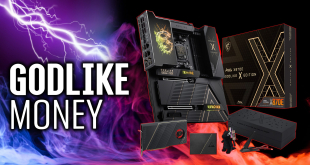ASRock supplies the Z87 Extreme9/ac in a large box that features plenty of information regarding the motherboard and its software.
Opening the front flap reveals a window that is used to give a peak at the motherboard itself.
Most of the accessories bundled with the Z87 Extreme9/ac motherboard are supplied in a high-quality draw-string bag. We think that this is a nice touch from ASRock as it increases the ease of which cables can be stored on a shelf or in a cupboard.
Manuals provide an oversight of the motherboard's specifications and features. An additional piece of documentation is related to the ASRock Home Cloud software.
A driver CD and case sticker are also provided.
The Z87 Extreme9/ac bundle is exactly what we'd expect for a board of this calibre, with the exception of an all-in-one front panel header block. As we have said many times in the past, we would like to see ASRock supplying a front panel connection block similar to MSI's M-connector and the Asus Q-connector.
The bundle consists of:
- 10x SATA 6Gb/s cables
- 2x Molex to SATA power adapters
- Coloured IO shield
- 3x single SLI rigid bridges (can be combined for 4-way configurations)
- 1x 3-way SLI rigid bridge
- Wi-SD Box (inc. USB 3.0 power cable and 2.5″ HDD screws)
The Wi-SD Box
ASRock uses the Wi-SD Box for many tasks. It functions as a SD/MMC/MS card reader, USB 3.0 4-port bay, and has the pair of wireless antennae built into its front panel.
Thankfully, ASRock builds the Wi-SD Box in a 5.25″ front factor, rather than the outdated 3.5″ size – support for which is omitted from many modern cases, such as our NZXT Phantom 630.
On its rear side, the Wi-SD Box can be used to secure a pair of 2.5″ drives in place. ASRock supplies the necessary mounting screws.
The use of Realtek's RTS5307 USB 3.0 card reader controller indicates that fast memory cards, such as the Class 10 ADATA Premier Pro, will not be bottlenecked by the connection speed, as they would be with a USB 2 controller.
An internal USB 3.0 header is used to take a pair of USB 3.0 connections from one of the motherboard's internal headers, before passing them onto the ASMedia ASM1074 hub controller which splits them into four ports.
ASRock uses the ancient floppy power connector to provide current to the Wi-SD Box. Many modern power supplies don't feature a floppy connector, so ASRock would be wise to ship future iterations of the Wi-SD Box with a SATA-to-floppy or molex-to-floppy power adapter. Luckily, we were covered by Seasonic's excellent Platinum 1000W power supply which ships with a molex-to-dual floppy power adapter.
A pair of wires connects the WiFi adapter found on the motherboard to its antennae located in the Wi-SD Box. ASRock makes these wires long enough to be routed behind the motherboard in a large case, such as our NZXT Phantom 630.
 KitGuru KitGuru.net – Tech News | Hardware News | Hardware Reviews | IOS | Mobile | Gaming | Graphics Cards
KitGuru KitGuru.net – Tech News | Hardware News | Hardware Reviews | IOS | Mobile | Gaming | Graphics Cards














excellent review Luke. ive been looking at a few of their boards recently and they seem to be improving their bioses in the last year. good looking board too.
excellent review Luke. ive been looking at a few of their boards recently and they seem to be improving their bioses in the last year. good looking board too.
What is their warranty like in Germany? I tend to stick with gigabyte as its very good here locally.
how much that montherboard
I ‘ve got one of these bad boys and the first impression that falls into my mind is this:
BADASS…!!! It worths every Euro i paid…
Excellent review as always…
Greetings from Greece…!!!
Nice review but you miss one important point about the exclusive DP-In (the gamer alternative to Virtu MVP).
With all these trends in modern technology and robotics,
it is starting to be a probability that many of us might soon become enslaved by it most especially if you recognize that there’s nothing
we all do at this time that does not involve modern technology
Hi Luke Hill. Need to see the main.jpg picture of the Z87 Extreme9/ac motherboard’s UEFI BIOS main page. I’m wondering which bios version is that. I’ve tried all versions found in the net and none can get me to set PCI’s other than PCI2 to gen1. Thanks.